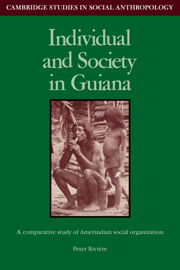Book contents
- Frontmatter
- Contents
- Acknowledgments
- 1 Peoples and approaches
- 2 The settlement pattern: size, duration, and distribution
- 3 Village composition
- 4 The categories of social classification
- 5 Aspects of social relationships
- 6 Autonomy and dependency
- 7 The individual in society
- 8 Guiana society and the wider context
- Notes
- Bibliography
- Index
- CAMBRIDGE STUDIES IN SOCIAL ANTHROPOLOGY
4 - The categories of social classification
Published online by Cambridge University Press: 01 October 2009
- Frontmatter
- Contents
- Acknowledgments
- 1 Peoples and approaches
- 2 The settlement pattern: size, duration, and distribution
- 3 Village composition
- 4 The categories of social classification
- 5 Aspects of social relationships
- 6 Autonomy and dependency
- 7 The individual in society
- 8 Guiana society and the wider context
- Notes
- Bibliography
- Index
- CAMBRIDGE STUDIES IN SOCIAL ANTHROPOLOGY
Summary
In the last chapter it was argued that a common feature of the region is that its various inhabitants maintain the fiction that a settlement is composed of a group of bilaterally related kin. This group often receives verbal recognition although the term involved usually has a broad semantic range, with its meaning dependent upon context in the same way as the English word “family.” At the same time the preference for settlement endogamy, together with what has been identified as its prescriptive nature, results in affines also forming part of this co-residential group of kin. This fact fits with the almost total absence of terms to designate a group of affines.
The possible exceptions to this claim are the Waiwai and the Panare. Concerning the former, Fock writes that “an important grouping is the affinal awåle,” but because he adds that it also “comprises the more distant relatives” (1963:194), it is probably a mistake to stress the purely affinal nature of this term. It seems probable that awåle refers to distantly related, and perhaps unrelated, people, all of whom are potential af fines. Among the Panare the term tunkonan may in certain contexts mean affines and is “often used as a sort of shorthand for indicating whether someone is marriageable or not” (Henley 1982:101). However, Henley is careful to point out that it would be wrong to regard the terms piyaka and tunkonan as denoting “discrete classes of ‘kin” and ‘affines’” (idem.). Furthermore, an individual's tunkonan include both related and unrelated people and, according to context, both co-residents and those living elsewhere.
- Type
- Chapter
- Information
- Individual and Society in GuianaA Comparative Study of Amerindian Social Organisation, pp. 42 - 53Publisher: Cambridge University PressPrint publication year: 1984



